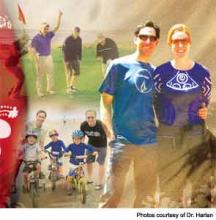Hospitalist Greg Harlan Embraces Everything Hospital Medicine Career Offers
If he wasn’t a physician administrator working for one of the largest physician management companies in the country, or a clinical instructor at a medical school, or a pediatric hospitalist picking up shifts at a children’s hospital, Greg Harlan, MD, MPH, would have a very different life.
He says he’d “promote vegetable gardens to kindergartners, hike the West Coast Trail, fight the obesity epidemic, and play lots of golf.”
Oh, yeah, one more: “Give every kid a bicycle.”
It’s quite the altruistic—some might say enviable—list. Instead, Dr. Harlan is hard at work as director of medical affairs at North Hollywood, Calif.-based IPC The Hospitalist Company. He is also a clinical instructor at the University of Southern California Medical School and moonlights as a pediatric hospitalist in Los Angeles.
He says he chose to focus on hospital medicine as a career while working as a young faculty member at the University of Utah.
“I noticed that lots of innovation, experimentation, and energy was coming from the newly formed hospitalist division,” says Dr. Harlan, one of nine new members of Team Hospitalist, The Hospitalist’s volunteer editorial advisory group. “I tried it out and loved it, especially getting to teach the students and residents for intense periods of time.”
At IPC, Dr. Harlan leads company-wide quality improvement (QI) initiatives, coordinates risk reduction activities, and directs the IPC-University of California San Francisco Fellowship for Hospitalist Leaders. He says he has a growing interest in “physician leadership, high-functioning teams, and physician groups’ well-being.”

I am really excited to put some science behind “leadership in medicine” and “optimal teamwork in medicine.” I think there is so much more we can learn and implement.
“I am using my QI background to apply these principles to better understanding how teams and leaders can thrive,” he says.
Question: Why did you choose a career in medicine?
A: Medicine is a cool combination of hard science, psychology, counseling, and teaching. It’s an amazing way to combine multiple passions and get to be involved on a very intimate level with many people.
Q: What do you like most about working as a hospitalist?
A: The focus on improving the system as a whole. Ultimately, the patients benefit, but so do many of the other stakeholders in the processes we touch.
Q: What do you dislike most?
A: It’s tough to take in-house call at night. It’s also hard to step in to many sick patients’ care for a short period of time, especially midway through their hospitalization.
Q: What’s the best advice you ever received?
A: Find the people who actually do the work. This is the concept of going to the front line, to see where the real work is being done. It never ceases to amaze me to find out the difference between what we think is going on and what is actually going on.
Q: What’s the biggest change you’ve seen in HM in your career?
A: Providers are getting squeezed a little more each year. There are growing pressures from many sides, and the providers are feeling “crunched.”
Q: Why is it important for you to continue seeing patients?
A: Feeling the joy and pain of actually providing care for patients is integral to leading the hospitalist movement. By acutely experiencing an electronic health record, or dealing with medication authorizations or handoffs, one stays in the real world of hospital medicine.
Q: What is your biggest professional challenge?
A: Balancing my multiple passions. I love being a teacher and still teach young med students at USC med school (my alma mater). I still enjoy seeing patients, too. I am most excited by a growing interest in leadership and teamwork, but it’s still in its development stage as a career path.


